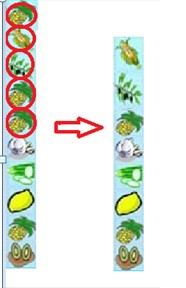LianLianKan
Time Limit: 2000/1000 MS (Java/Others) Memory Limit: 32768/32768 K (Java/Others)
Total Submission(s): 1760 Accepted Submission(s): 547
Problem Description
I like playing game with my friend, although sometimes looks pretty naive. Today I invent a new game called LianLianKan. The game is about playing on a number stack.
Now we have a number stack, and we should link and pop the same element pairs from top to bottom. Each time, you can just link the top element with one same-value element. After pop them from stack, all left elements will fall down. Although the game seems to be interesting, it's really naive indeed.

To prove I am a wisdom among my friend, I add an additional rule to the game: for each top element, it can just link with the same-value element whose distance is less than 6 with it.
Before the game, I want to check whether I have a solution to pop all elements in the stack.
Input
There are multiple test cases.
The first line is an integer N indicating the number of elements in the stack initially. (1 <= N <= 1000)
The next line contains N integer ai indicating the elements from bottom to top. (0 <= ai <= 2,000,000,000)
Output
For each test case, output “1” if I can pop all elements; otherwise output “0”.
Sample Input
2
1 1
3
1 1 1
2
1000000 1
Sample Output
1
0
0
Source
2012 ACM/ICPC Asia Regional Changchun Online
Recommend
liuyiding
想了半天不知咋办,在网上搜了一下原来这样也可以...
#include <algorithm>
#include <iostream>
#include <cstring>
#include <cstdio>
#include <vector>
using namespace std;
#define MAXN 1010
#define INF 0xFFFFFFF
int n;
vector<int>v;
void solve() {
int flag, i;
vector<int>::iterator it1, it2;
while (1) {
flag = 0;
if (v.size() <= 1) break;/*只有一个元素的肯定不行*/
it1 = v.begin();
for (; it1 != v.end(); it1++) {
for (it2 = it1 + 1, i = 1; i < 6 && it2 != v.end(); i++ , it2++) {
if (*it1 == *it2) {
v.erase(it1);/*这里删除了it1后it2会往回移动一个*/
v.erase(it2-1);/*所以由上面的可知这里删除it2-1位置*/
flag = 1 ; break;
}
}
if (flag) break;
}
if (!flag || !v.size()) break;/*如果flag为0或v为空退出*/
}
if (v.size()) printf("0
");
else printf("1
");
}
int main() {
//freopen("input.txt", "r", stdin);
int tmp;
while (scanf("%d", &n) != EOF) {
v.clear();
for (int i = 0; i < n; i++) {
scanf("%d", &tmp);
v.push_back(tmp);/*全部插入vector*/
}
solve();
}
return 0;
}